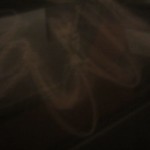Reflection through Water
This project is in response to several themes covered over the course of the semester, with a particular focus on the Week 10 reading of Attar’s Conference of the Birds. A mathnawi, or epic poem, Conference of the Birds describes the mystical journey of thirty birds on a quest to discover truth. A wonderful recount of Sufi tradition and lessons of patience and self-discovery, the poem memorably concludes with the birds’ finding “truth” in their own reflection in a lake.
In my response, I attempt to recreate the Sufi idea that God is not external or separate from the universe—but rather, “a totality of existence.” As such, God is intrinsic to his believers and indefinitely tied to our inner egos. As Attar says to the birds, in order to truly experience Islam, one must abandon the self and the establishment of religion. It is these conceptions that prohibit one from reaching the batin and genuinely experiencing Islam. Attar explains to the birds that before reaching the truth, one thinks of God as being veiled and intangible. However, after the journey of truth—symbolically undertaken by the birds in this story—we are able to feel a connection with God that draws on a higher plane of reality, or haqiqa. Reaching this state of enlightenment, we become aware not only of God’s existence as internal to us, but can experience him as one with us.
Yet one of the more controversial aspects of Attar’s message is the very ending, when the birds look into a lake to find only a reflection of themselves (and not the mystical Simorgh). I chose to focus on this concept in my creative response particularly because of the many meanings it can hold for readers of this poem. I used a flat, black bowl in which I spelled out “Allah” in Arabic using water. I then used a solid, white clay coloring pencil to repeat the same inscription beneath water that I poured into the bowl. The color pattern used—black, white and translucent—is meant to represent the distinct ways in which we understand God (as within us, as external or internal to us, and as unified with us). In the fourth picture shown, I photograph myself as a reflection in the pool. This is meant to represent my own journey toward understanding Islam, and the way that this knowledge has reflected on my own faith. Through the collage of pictures shown, I let the water dissipate for several hours, until the writing became blurred. Yet as the word blurred with time, it also become more prominent on the black surface—this is indicative of the notion that religious enlightenment, of the type found in Attar’s poem, becomes more prominent throughout our personal journeys.












